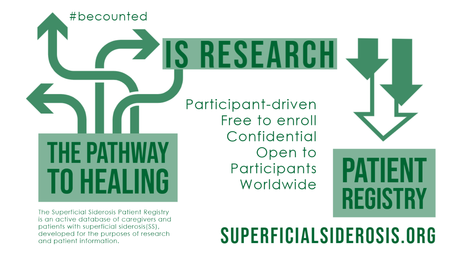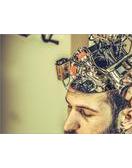
Our superficial siderosis Facebook family is a tightknit group. We share our problems and successes; we listen and learn from each other. It doesn't matter that we've never met because, along the way, it began to feel like we know each other. Still, no matter how our group has grown these past years, there will always be one more diagnosis, and one more family learning someone they love has superficial siderosis.
The need for research
We've been beating the research drum hard. Research takes time, and steps must be in place so real progress can happen. One easy step is signing up for the patient registry. No matter where in the world you live, our superficial siderosis patient registry will soon become an essential lifeline to new research projects. The Brain Donation Project is a hard step. As we've said before, it's not a happy place, contemplating your mortality, but more effective therapeutic strategies will not come until our researchers have brain tissue under a slide. We have five volunteers so far, who have agreed to become brain donors upon their passing. End-of-life donation of brain tissue for superficial siderosis research is the most generous gift you can make. The hard truth is not only will we be saying goodbye to one of our family, research stalls while we wait for a donor-kind of a catch-22 situation.
Every step is important
We recognized that there was still vital work to be done while we waited. Having a prominent web presence has been a large part of the SSRA advocacy and education program. We've worked hard to show up when someone googles " is superficial siderosis fatal?," " superficial siderosis research," or " Where can you donate a brain for superficial siderosis research? ". Sometimes a door opens most unexpectedly, especially when you get a Saturday night call telling you to check your email- right now.
Dr. Levy has expressed a need for ten donors at a minimum. Every brain donated will bring unique qualities. Some will have been exposed to chelation therapy, allowing a visual look at the process. Some will be in the late-stages of superficial siderosis, revealing how it ravages the brain. Male or female- will gender expose why males are more often affected? Hopefully, there will be one that may show signs of healing. It makes you wonder which quality would be the most helpful?
Answering the call
A donor brain in the very early stages of superficial siderosis would require someone young to middle-aged. Death would not be natural- an accident or unrelated cause. The one quality thought to be the most elusive will become our first completed donation thanks to the generosity of willing strangers and a google search. They didn't know about superficial siderosis until quite recently. Our donors' wife said learning about the disorder explained a lot about the last few years.
The pathophysiology study will breakdown the mechanics of what is happening to the cells and neurons. Donor tissue from different stages of superficial siderosis will reveal this disorders secrets so our researchers can discover new therapies to slow the progression. As knowledge grows, we hope the brass ring will someday be in reach- finding a way to reverse the damage.
The Natural History Study will be much simpler. Volunteers who make the decision to decline chelation or any therapy will be recruited. The natural progression of superficial siderosis will be allowed to go forward with every step tracked by your local physician. They will report the data to the study manager on a regular schedule. A medical history will be collected, beginning from when the study participant showed zero symptoms. Your disease will be allowed to progress until the natural end. This allows researchers to learn the course this devestating disorder takes. Our patient registry will play an important role.
To our donor family ,from the entire superficial siderosis community, we say Thank You
Donation is a precious gift that will benefit every one of us-patients, caregivers, and loved ones. To help make a difference to those who follow by giving their body a fighting chance with a real opportunity to live a better life. Our work to fund both the pathophysiology and Natural History Study is hugely important, now more than ever, thanks to the generosity of our first donor.
For information about The Brain Tissue Donation Project download the information packet here.
If you would like to support the Natural History and Pathophysiology Study you may donate here.
$5,000 is needed to set-up the Natural History Study Network. The life of the study may take up to an additional $250,000 to complete.

